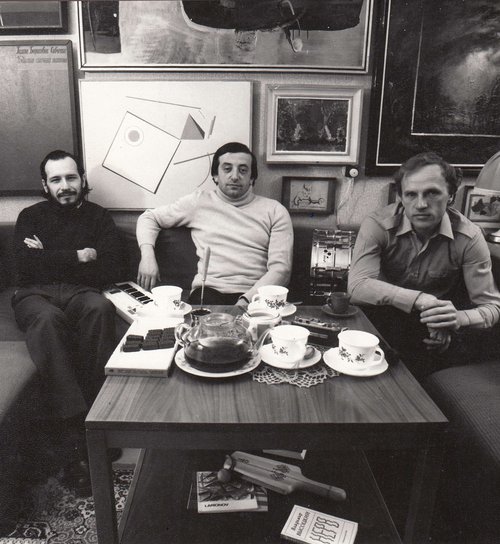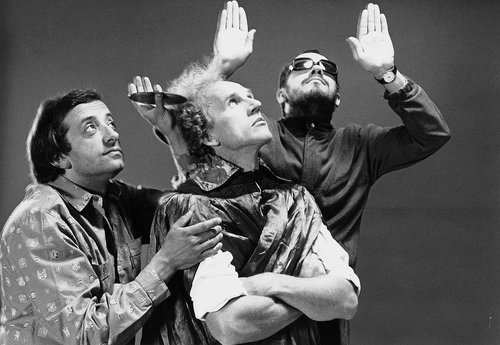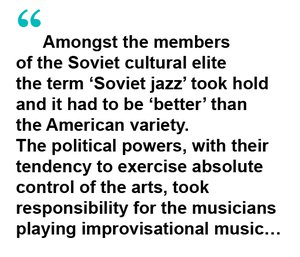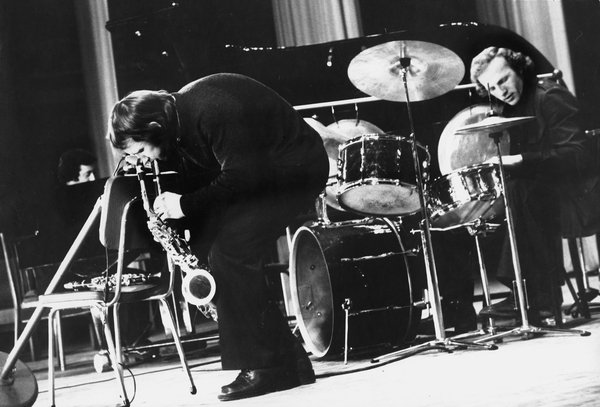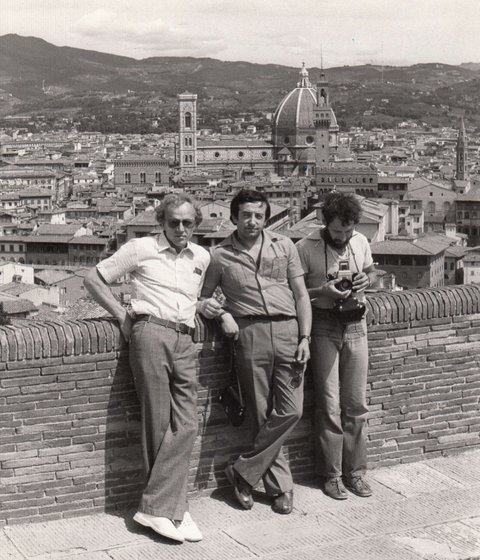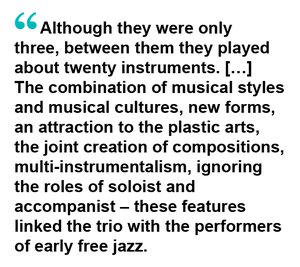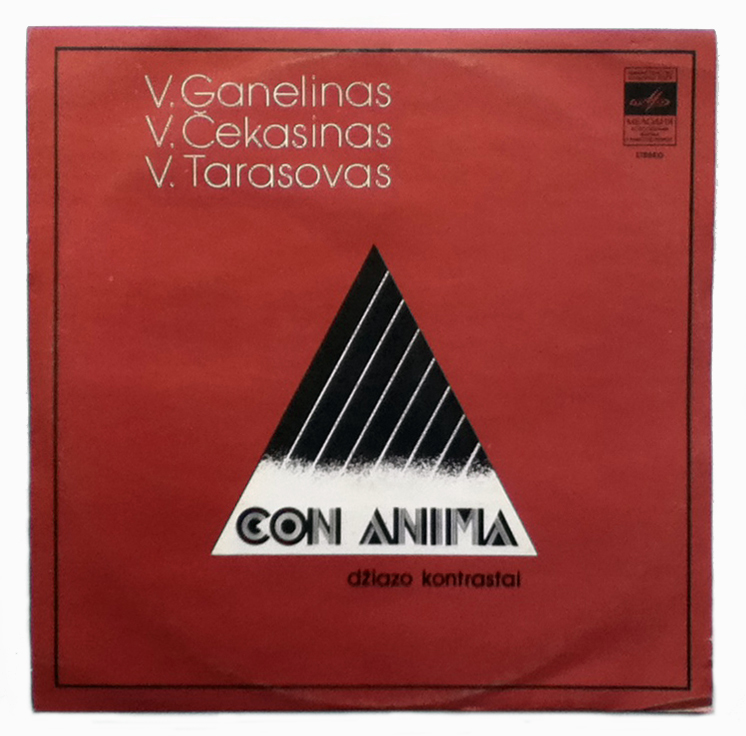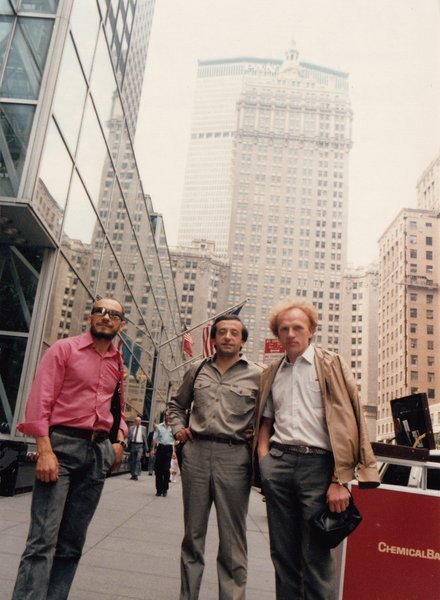Rūta SKUDIENĖ | Con Anima: The Metamorphoses of Jazz
Free jazz has to be very strong in energy. Only then can this music have lasting value, be relevant, listened to, and discussed even after the passage of decades. The well-known German music journalist Joachim-Ernst Berendt who specialised in jazz once called the music of the Ganelin-Chekasin-Tarasov Trio ‘the best organised and most professional free jazz I’ve heard in years’ (Down Beat, 1980, USA). Today, with time being the most objective judge, one can only be amazed by the artistic legacy of the trio that existed from 1971 to 1987 and their ability to survive and adapt to the dreary years of Soviet stagnation. And, moreover, to create, perform, record music that was so new for the times, and to travel the world… The early years of the 1970s were particularly unfavourable to the development of jazz in Lithuania: on the one hand, the attention of young people was caught by the wave of rock music coming from America and Europe and finally reaching Lithuania. But even more important was the self-immolation of Romas Kalanta in Kaunas in 1972, a symbol of the countercultural youth movement and resistance to the occupation regime. Anything that posed a threat to Soviet ideology was suppressed and its initiators persecuted. Many of the promising musicians who played jazz during the years of the Khrushchev Thaw found refuge, so to speak, in the bars and restaurants in the capital and other Lithuanian towns. One may remember the unsuccessful efforts to organise jazz festivals at the end of the 1960s (the only one up to the first Birštonas festival in 1980 was Youth-68 in Elektrėnai). Right up to perestroika because of a decision by the Central Committee of the Soviet Communist party Lithuanian radio almost never broadcast pop or jazz music from abroad. All the same, the iron curtain could not cut the Soviet Union from the rest of the world. Even ideologically inspired culture could not fail to develop. And it did develop in its own way, autonomously, and paradoxically in an innovative fashion.
The primitive Bolshevik slogans about jazz and the betrayal of the motherland no longer worked. Amongst the members of the Soviet cultural elite the term ‘Soviet jazz’ took hold and it had to be ‘better’ than the American variety (by the way, the term ‘Soviet rock’ did not exist even though music groups were being formed, similar in their make-up to Western groups – they were called vocal instrumental ensembles or vocal instrumental youth groups). The political powers, with their tendency to exercise absolute control of the arts, took responsibility for the musicians playing improvisational music… This area was strategically and cautiously entrusted to functionaries in the All-Union Young Communist League.
Already at the beginning of the 1960s – from 1963 – there was for a while a so-called youth café in Vilnius (the address now would be 22 Vilnius Street), an unofficial jazz club, the activities of which were minutely observed and overseen by Soviet political officers, functionaries from the Communist Party and the KGB. Another meeting place for local and foreign intellectuals, artists and dissidents was Neringa, a café in the city centre. Jazz was played on the small modern stage in the evenings, amongst the musicians were two of the future members of the Trio, that is Ganelin and Tarasov. By the end of the 1960s jazz music was no longer being played in these places.
The organisers of the legendary and one of the oldest jazz festivals in Europe, the Tallinn Jazz Festival, were also functionaries in the All-Union Young Communist League. The apogee of the Tallinn festival was reached in 1967 when in the packed Kalev Sports Hall besides performers from Lithuania – the early Ganelin Trio and the Oleg Molokoedov Quartet – and other famous foreign musicians, the renowned Charles Lloyd Quartet from the USA also performed there. All the same, the manifestations of free thought connected to jazz were too obvious and so soon after that the Tallinn festival was closed down. The first Birštonas Jazz Festival in 1980 was dedicated to the 16th Communist Party Congress and World Youth Day – nobody lost any sleep over that ‘dedication’, it was simply what was required. Most importantly, at long last there was an officially approved venue where jazz could be played without any restrictions.Unlike in Lithuania, in the 1960s and 1970s there existed a diverse, semi-underground jazz scene in various Russian towns – in Moscow, Leningrad, Gorky, Novosibirsk and elsewhere, a scene which had a proportionately larger number of adherents of this genre. During the Soviet period this became a way of life, a kind of refuge for people of a freer spirit, a world in which the form of communication was the language of Aesop. The culture of those who refused to conform was that of the underground or semi-underground – art, poetry, music, and eagerly read samizdat[1] literature. All the same, the Baltic countries in the consciousness of people of those times remained more Western, marked by the experience of independence in the interwar period. According to contemporaries, creative work there was hindered to a lesser degree…
The social processes which took place in the Soviet Union from the times of the Khrushchev Thaw, which began after Stalin’s death, up to Gorbachev’s perestroika, together with the underground youth movements and protests, provoked the emergence of new artistic expressions. The composition of ensembles, in particular those playing jazz was formed with musicians migrating from one Soviet republic to another. This exchange of performers encouraged forms and opportunities of a new and different quality of making music, inspiring creativity.
The group that became best known in Vilnius in the 1970s was the Ganelin Trio, the only officially approved jazz collective in Lithuania – also known as the GTCh (an abbreviation given to the ensemble by the Russian music critic Efim Barban). Up till that time the pianist and composer Vyacheslav Ganelin, the trio’s leader, had for a whole decade been looking for partners on the same level as him. Born in 1944 not far from Moscow, he and his parents at the beginning of the 1950s settled in Vilnius where at the Lithuanian State Conservatory (now the Lithuanian Academy of Music and Theatre) he completed his music studies. It was at the conservatory that he founded a big band and a quartet, actively promoting jazz in the 1960s, and taking part in the Tallinn and Elektrėnai jazz festivals. Recordings of his early work on Lithuanian radio have survived. The multi-instrumentalist and composer Vladimir Chekasin arrived in Vilnius from Sverdlovsk in 1971, while the drummer and percussionist Vladimir Tarasov had come from Arkhangelsk a little earlier, in 1968. And so, through a fortuitous confluence of circumstances musicians from the far-flung corners of the Soviet Union came to a Baltic country, where, in their own words, there was the least hindrance for them to create, and formed their celebrated jazz ensemble in Vilnius. Eventually the trio came to be written about in all the European and American jazz reference works, making jazz in Lithuania famous throughout the world and giving one of the greatest impetuses to the evolution of this genre, as well as kick-starting the Vilnius school of jazz.From 1971 on the musicians would prepare a whole new programme every year, revealing their newest creative endeavours. Their first programmes (Consilium, Triptych, Postludium, Ad libitum, and Ex libris) became the object of discussion amongst critics and their audiences because of their newness and impact. In 1974 the Ganelin-Chekasin-Tarasov Trio was granted the status of being affiliated with the philharmonic: it became one of the first Soviet jazz collectives during times that were unfavourable to jazz music and was out of prudency called the Contemporary Chamber Music Ensemble of the Lithuanian State Philharmonic Society. This was not only the first Lithuanian but the first Soviet jazz ensemble to visit the countries of Eastern and Western Europe but also America, the homeland of jazz. Over time, and in particular during the period of perestroika, after the persistent invitations of foreign festival organisers and concert agencies and negotiations with Gosconcert, the only organiser of tours abroad during Soviet times that had the final word as to who could or could not represent Soviet culture abroad (only many years later did the musicians find out when and to which places they had been invited), the trio went not on an ideological mission but to appear at prestigious jazz festivals or venues (Jazz Jamboree, Pori Jazz, North Sea Jazz Festival, Jazz Yatra, etc.). The ensemble was well known not only in the Soviet Union: they were also written about by influential international jazz critics in the West. And for good reason.
Although they were only three, between them they played about twenty instruments: Ganelin – the piano, synthesizer, percussive instruments, trumpet, and drums; Tarasov – the whole armoury of percussion instruments, sometimes also whistles; Chekasin – flutes, clarinets, all kinds of saxophones, often playing two at the same time like Roland Kirk. The musicians would sometimes expand the traditional ways of getting sounds out of instruments and unexpectedly supplement the range of instruments with random ‘non-musical’ objects, with a particularly rich arsenal of percussive instruments. The combination of musical styles and musical cultures, new forms, an attraction to the plastic arts, the joint creation of compositions, multi-instrumentalism, ignoring the roles of soloist and accompanist – these features linked the trio with the performers of early free jazz and the Art Ensemble of Chicago, their work being compared to the compositions of the saxophonist and composer Anthony Braxton.The trio’s programmes An Album for Young People, Catalogue, and Home Music are a testament to their propensity for theatricality and their desire to enhance the impact of their music with visual effects. The trio were also masters when it came to playing in the style of traditional jazz but they never imitated or copied the styles of other musicians. A good example of that could be their “Mackie Messer” (Mack the Knife), one of the most popular numbers in their concert repertoire. The trio would often play it for an encore and created a real masterpiece in miniature from Kurt Weill’s simple ditty, with their version called a ‘non-standard standard’.
In leafing through the pages of Vladimir Tarasov’s book Trio (Vilnius: Baltos lankos, 1998) one is amazed not only by the meticulously described activities of the ensemble, the correspondence with representatives of the world’s jazz elite, but also by the fact that almost all the people played an important role on the trio’s creative path are mentioned. The author writes about the paradoxes of Soviet existence, the crude ignorance of functionaries working in the field of culture, the psychological pressure they were subjected to by the mandatory KGB overseer, given the sarcastic name of ‘coat’, who accompanied the musicians on their tours.
In spite of all that, the ensemble was indeed very successful. One can speak and read about it and share reminiscences but those are only markers. The recordings were and remain the very best witness to its artistic achievements. Up to 1985 the trio had prepared nineteen programmes with a discography comprised of 43 albums in LP and CD format distributed in countries throughout the world.Invited more than once to Poland and after long negotiations with the Ministry of Culture of the USSR, the trio finally took part in the Jazz Jamboree festival in 1976. The programme Poco a poco garnered the highest praise from foreign critics and listeners. The Polish press wrote: ‘The biggest surprise was the concert given by the Soviet jazz trio. We have waited several years for its appearance and we were not disappointed. The Contemporary Chamber Music Group of the Lithuanian State Philharmonic Society […] is one of the most interesting collectives on the musical map of Europe. It is intuitive music, free jazz with links to tradition’ (Express Wieczorny, 03 11 1976). The Polish record company Muza released a fragment of the trio’s performance at the festival that year, and before that Pronit had already released a programme recorded in Moscow in 1975.
In 1976 Con anima, the first programme specially adapted for a studio recording, was recorded at the Vilnius Recording Studio (a branch of Melodiya, the state-owned major record company of the Soviet Union) and released in 1977. The trio felt and knew very well the difference between what was required in a recording studio and at live concerts: they would specially and very carefully adapt their programmes for recordings, while their concerts would always be marked by theatricality and spontaneity. The second programme recorded at the Vilnius studio, Concerto grosso (1978), caused real confusion amongst the members of the Melodiya arts board in Moscow – the radical quality of the musical concept simply stunned the management which was intolerant of anything avant-garde. A document was sent out to Melodiya’s branches requiring the control of the ideological and artistic level of recorded music, while the album Concerto grosso was released only three years later – in 1981.
In the 1970s the Vilnius Recording Studio was a progressive, creative recording laboratory for musicians of all genres. Their, as it were, hand-crafted recordings (there was no digital montage nor many other things now available) still surprise one because of the musical energy, quality and culture of sound. It was at the Vilnius studio that GTCh’s programme Non troppo was also recorded and which the German company Enja Records released in 1983, by-passing Melodiya and with Tarasov astutely ordering a recording through the Lithuanian Composers’ Union.More than one official request from foreign producers to release the music of Ganelin, Chekasin and Tarasov beyond the borders of the Soviet Union was categorically rejected by the management of Melodiya. From the point of view of the music business today this was a strange and incomprehensible position to take – after all, the West paid in hard currency for the work (concerts and recordings) of musicians from Eastern Europe like they did for oil. It is interesting to note that during the Soviet period the organisation Mezhdunarodnaya Kniga (International Book), strictly controlled by the KGB, would put out books and recordings for sale internationally that were of better appearance and quality than those for domestic consumption without the knowledge of the authors and performers. The strategy of the suitcase with a false bottom comes to mind – there is more in it than declared. The Mezhdunarodnaya Kniga spider’s web encompassed not only Europe but also the most far-flung and strangest distribution points. It is known that the organisation signed no agreements with the creators as regards catalogues or contracts nor made them public…
An absolutely unique factor on the trio’s creative path was the attention paid to it by the small independent British record label Leo Records. Leonid Feigin, the company’s founder, an immigrant from Russia and now on the other side of the iron curtain, passionate in promoting new music from Russia and Eastern Europe, released most of the trio’s concert programmes.[2] Mostly they were recordings of concerts and probably semi-legal, with titles in preponderance like Live in East Germany, Leningrad, Moscow, West Berlin… From the point of view of the authors and related rights these publishing activities were not legal but the performers never made any claims against the record label. Symbolically, one can compare the activities and services to free jazz coming out of Eastern Europe with one of the oldest American jazz record labels Blue Note Records in the 1950s and 1960s when this legendary company began to release albums of avant-garde permeated free jazz music. It was my pleasure to work with Leonid Feigin in putting together the compilation album Lithuanian Jazz 1929–1980 (Semplice Records, 2003) which had on it two of the trio’s compositions from releases by Leo Records. We met in December 2003 in Vilnius when Ganelin, Chekasin and Tarasov put on a unique concert at the Lithuanian National Philharmonic Society. It so happened that the above-mentioned album was launched at the press conference before the concert. Leo Records hoped that the trio would begin to revive their concert activities but after Ganelin emigrated to Israel in 1987 the musicians’ creative collaboration was not renewed.Even though they have not renewed creative collaboration on a permanent basis (apart from some rare reunion concerts), the experience from the times when they were an ensemble is being developed and transformed in the on-going activities of the members of the trio: they play solo and together with various jazz, classical and ethnic musicians, as well as composing music for theatre and film. Ganelin and Tarasov have written some substantial oratorio type works. Tarasov brought together the large Lithuanian Art Orchestra, with a changing formation and musicians of different types; similarly, Chekasin has always appeared with large diverse collectives (made up mostly of students) whose programmes were not infrequently marked by theatrical extravagance. Besides that, Tarasov today is known as a visual artist with sound still playing an important role in his installations.
Translated from the Lithuanian by Romas Kinka
[1] Samizdat was a key form of dissident activity across the Soviet bloc in which individuals reproduced censored and underground publications by hand and passed the documents from reader to reader.
[2] It is of a particular interest that the label itself was founded (in 1979) after Leonid Feigin obtained a tape of the GTCh Trio, as Andrey Henkin calls it, ‘Russia’s most progressive import’: ‘When no labels expressed interest in releasing it he decided to form his own company. Feigin realized that he needed to establish some credibility before releasing something as unorthodox as Ganelin so he began with two releases by Chicago pianist Amina Claudine Myers, saxophonist and son-of-Ukrainian immigrants Keshavan Maslak, and then Ganelin. The first three releases were both prophetic and indicative of Feigin’s conscious internationalism or lack of it.’ (Henkin 2014). For more on Feigin’s views see https://www.allaboutjazz.com/leo-records-by-andrey-henkin.php/.
